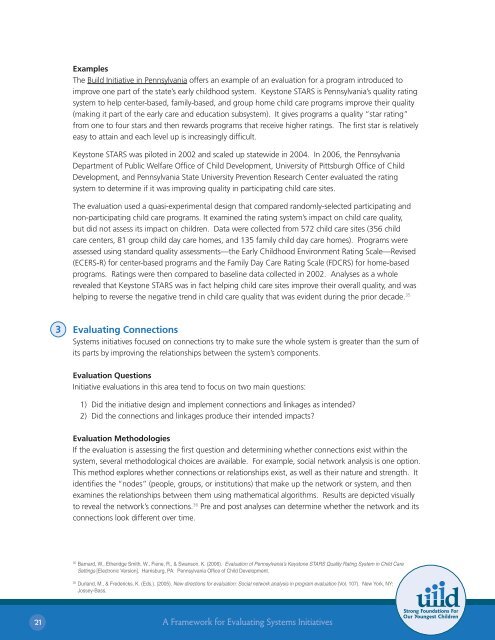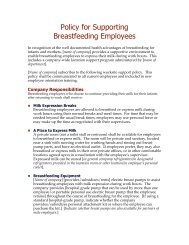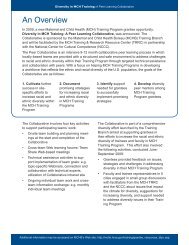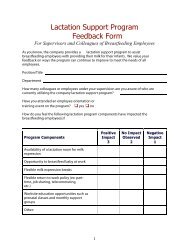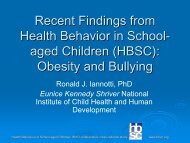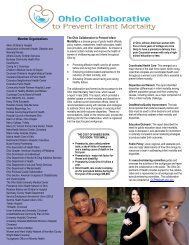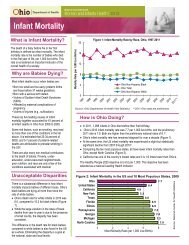A Framework for Evaluating Systems Initiatives
A Framework for Evaluating Systems Initiatives
A Framework for Evaluating Systems Initiatives
- No tags were found...
You also want an ePaper? Increase the reach of your titles
YUMPU automatically turns print PDFs into web optimized ePapers that Google loves.
ExamplesThe Build Initiative in Pennsylvania offers an example of an evaluation <strong>for</strong> a program introduced toimprove one part of the state’s early childhood system. Keystone STARS is Pennsylvania’s quality ratingsystem to help center-based, family-based, and group home child care programs improve their quality(making it part of the early care and education subsystem). It gives programs a quality “star rating”from one to four stars and then rewards programs that receive higher ratings. The first star is relativelyeasy to attain and each level up is increasingly difficult.Keystone STARS was piloted in 2002 and scaled up statewide in 2004. In 2006, the PennsylvaniaDepartment of Public Welfare Office of Child Development, University of Pittsburgh Office of ChildDevelopment, and Pennsylvania State University Prevention Research Center evaluated the ratingsystem to determine if it was improving quality in participating child care sites.The evaluation used a quasi-experimental design that compared randomly-selected participating andnon-participating child care programs. It examined the rating system’s impact on child care quality,but did not assess its impact on children. Data were collected from 572 child care sites (356 childcare centers, 81 group child day care homes, and 135 family child day care homes). Programs wereassessed using standard quality assessments—the Early Childhood Environment Rating Scale—Revised(ECERS-R) <strong>for</strong> center-based programs and the Family Day Care Rating Scale (FDCRS) <strong>for</strong> home-basedprograms. Ratings were then compared to baseline data collected in 2002. Analyses as a wholerevealed that Keystone STARS was in fact helping child care sites improve their overall quality, and washelping to reverse the negative trend in child care quality that was evident during the prior decade. 353<strong>Evaluating</strong> Connections<strong>Systems</strong> initiatives focused on connections try to make sure the whole system is greater than the sum ofits parts by improving the relationships between the system’s components.Evaluation QuestionsInitiative evaluations in this area tend to focus on two main questions:1) Did the initiative design and implement connections and linkages as intended?2) Did the connections and linkages produce their intended impacts?Evaluation MethodologiesIf the evaluation is assessing the first question and determining whether connections exist within thesystem, several methodological choices are available. For example, social network analysis is one option.This method explores whether connections or relationships exist, as well as their nature and strength. Itidentifies the “nodes” (people, groups, or institutions) that make up the network or system, and thenexamines the relationships between them using mathematical algorithms. Results are depicted visuallyto reveal the network’s connections. 36 Pre and post analyses can determine whether the network and itsconnections look different over time.35Barnard, W., Etheridge Smith, W., Fiene, R., & Swanson, K. (2006). Evaluation of Pennsylvania’s Keystone STARS Quality Rating System in Child CareSettings [Electronic Version]. Harrisburg, PA: Pennsylvania Office of Child Development.36Durland, M., & Fredericks, K. (Eds.). (2005). New directions <strong>for</strong> evaluation: Social network analysis in program evaluation (Vol. 107). New York, NY:Jossey-Bass.21A <strong>Framework</strong> <strong>for</strong> <strong>Evaluating</strong> <strong>Systems</strong> <strong>Initiatives</strong>


